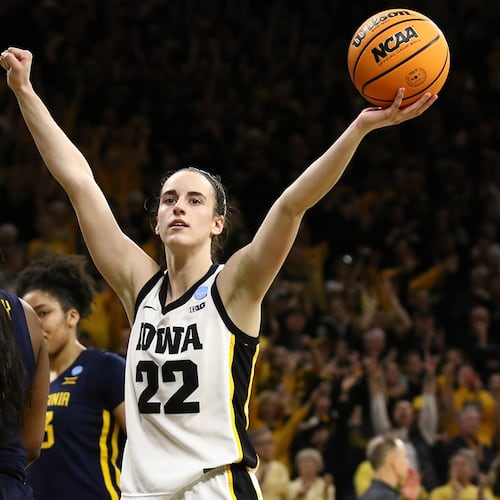The Big Ten either has righted a wrong or wronged a right. We can’t know how the conference’s latest decision – its members just voted 14-0 to play football this fall, five weeks after voting 11-3 not to play – will be viewed over the fullness of time, but this much we do know: In the matter of crisis management, the “B1G” came up small.
Nothing forced the league to take a “final” vote in August. The Big Ten loves to look down its nose at conferences it considers less enlightened – the SEC and the Big 12, to name two – and moved to get ahead of a pandemic that changes week-to-week. The Big Ten’s expectation surely was that the four other Power Fivers would line up behind it, brothers in cancellation. Way to read the room, B1G.
Only the Pac-12, the sidecar to the Big Ten’s shiny Harley, followed. The SEC, ACC and Big 12 played for time, hoping perhaps against hope that the virus number would recede and/or better methods of testing might be found. Both things happened. Football-wise, the ACC is under way. The Big 12 and the SEC are set to commence soon. In seeking to seem visionary, the Big Ten wound up looking short-sighted.
We pause for a disclaimer: There’s nothing short-sighted about trying to safeguard the health and welfare of human beings. That, the Big Ten told us in August, is why it did what it did. But now it’s September, and the same league is saying, “After further review, we’re good to go.”
Disclaimer No. 2: There’s no sin in admitting a mistake. At issue, however, is whether the Big Ten indeed erred in its first vote. Nobody knows where COVID is heading. Even as the ACC was wading through its opening weekend, the league was forced to postpone the Virginia-Virginia Tech game of Sept. 19. On Tuesday, three days after upsetting Kansas State, Arkansas State announced its Saturday game with Central Arkansas has been pushed back to Oct. 10 to allow the team to deal with a “depleted position group.”
If you ask any SEC bigwig, “As of this moment, are you absolutely sure you’ll be able to get through the season?”, the only truthful answer would be, “We’re hopeful, yes. Are we sure? No.” LSU coach Ed Orgeron disclosed Tuesday that “most” of his players had tested positive. (Coach O took this as a sign that they’ll now have immunity for the season.) The ACC has mandated that at least eight of its 15 teams must keep playing for its season to keep going; those 15 are based in 10 states, some of them far-flung.
In a time when there are no givens, the prudent course was to wait as long as possible before deciding. The Big Ten decided and then saw itself become – apologies for the continuing use of this metaphor, but in this case it’s more than a metaphor – a political football. Everyone from Justin Fields to Jim Harbaugh to the entire state of Nebraska to the current occupant of 1600 Pennsylvania Ave. raged against the rush to recuse. Penn State athletic director Sandy Barbour said she wasn’t sure there’d even been a vote, which forced the Big Ten to respond, “Well, there was, and it was 11-3 against.”
And now: 14-0 for. What the heck happened? Did somebody find a COVID cure? (Not that anyone’s aware.) Is the Big Ten choosing now to ignore the “scary” data that drove its August decision? What happened to the growing concern over myocarditis?
Over the past month, an apparently reliable test delivering rapid results has become available, allowing for daily – as opposed to twice-weekly – testing. An Ohio State study revealed that four of 26 athletes who tested positive showed signs of myocarditis but – big “but” here – that “COVID-19-related myocardial injury in competitive athletes and sports participation remains unclear.”
In a statement released by the Big Ten on Wednesday, Ohio State team physician Dr. Jim Borchers said: “The data we are going to collect from testing and the cardiac registry will provide major contributions for all 14 Big Ten institutions as they study COVID-19 and attempt to mitigate the spread of the disease among wider communities.”
So: The Big Ten is performing a public service. Three cheers for the B1G!
As for the football part: The Big Ten plans to play eight conference games, plus the league title tilt Dec. 19. You can already hear the gnashing of teeth emanating from Tuscaloosa, Ala., Athens, Ga., and Gainesville, Fla. With only three Power Five leagues playing, the SEC figured its chance of receiving at least two berths in the four-team College Football Playoff was something approaching a lock. Now (and again), Ohio State/Michigan/Penn State/Wisconsin are in the mix.
Which means: The college football season is, as of today, something close to the college football season that was supposed to be, at least on the FBS level. Forty percent of the mid-major Group of Five won’t be participating, and some teams are facing schedules so abbreviated that you wonder why they’re bothering – Air Force is playing two games; one against Army, the other versus Navy – but hey, it’s college football! Color and pageantry! Toe meets leather!
Far be it from me to rain on this circuitous parade, but what happens if the Big Ten had it right the first time? What happens if, a month from now, every stadium is shuttered until 2021 at the earliest? What if campuses are again closed and the long-expected autumn spike arrives with full force?
Nobody has that answer. In mid-September, there’s no answer to be had. There is, however, one more conference about to play football with its fingers crossed. If you’re the Big Ten, the last thing you want is to hold another vote.
About the Author
The Latest
Featured



